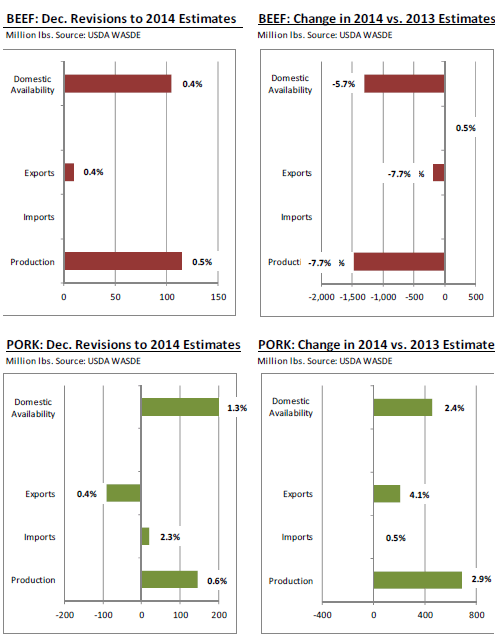



CME: Ag Department Bolsters Pork Production Estimates
US - USDA updated its forecasts of beef, pork and poultry supply availability and use for 2013 and 2014, write Steve Meyer and Len Steiner.The charts below offer a graphic representation of both the changes made to the 2014 forecast compared to the previous month and the year/year change in output and supply availability.

Below is a brief recap of the latest data and our take on some of the implications for pricing going forward:
Pork: At this point USDA appears to think that the impact of the PEDv disease on US pork production will be somewhat limited. USDA bolstered its estimates of US pork production by 145 million pounds (+0.6) and also lowered its estimates of US pork exports. This increased overall US domestic pork availability for 2014 by 255 million pounds vs. the November forecast (+1.3 per cent).
Now USDA thinks that domestic pork availability in 2014 will be about 458 million pounds or 2.4 per cent higher than a year ago. It is fair to say that at this point the USDA numbers offer a somewhat more bearish view of the market than what futures are trading. Pork exports are still expected to increase by some 4 per cent, which implies that China/Hong Kong demand will be about steady vs. 2013 and it makes no assumptions as to Russian purchases.
Beef: USDA now expects total US beef production in 2014 to be 24.288 billion pounds, up about 115 million pounds (+0.5 per cent) compared to the forecast presented in November. US beef supplies for next year are still expected to decline sharply and the most recent update forecasts total US beef production in 2014 to decline some 1.472 billion pounds (-5.7 per cent) compared to 2013 levels. The decline in total output reflects expectations for a sharp reduction in the number of cattle coming to market.
USDA did not issue a July estimate of the calf crop but analysts peg the 2013 calf crop down about 2 per cent compared to the prior year. Supplies of cattle on feed remain limited and the expectation is for placements to remain constrained for much of 2014. Demand for replacement heifers remains strong and this should limit the number of female calves going into feedlots.
USDA indicated that they raised domestic production mostly because they now think steer carcass weights in 2014 may be a bit higher than earlier thought. There was some expectation earlier in the fall that the removal of Zilmaxx could cause steer weights to drift below year ago levels but that has not yet happened. However, it is not entirely clear that the industry will continue to advance weights higher in 2014.
After all, there is a push to develop programs that are ractopamine free and thus would open opportunities in markets that so far ban US beef on that basis. Also, it is possible that part of the reason weights continued to perform well this fall is because feedlots placed more yearling on feed during the summer months than a year ago. It remains to be seen how steer weights will fare once placements return to a more normal placement pattern.
USDA made no changes to its estimate for beef imports, which are expected to be flat in 2014. This will largely depend, in our view, on what China does in terms of sourcing beef from Australia, New Zealand and Uruguay. Limited US cow meat supplies should push up lean beef prices in the US and thus create more opportunities for those countries to supply the US market.
As for US beef exports, USDA only slightly changed imports for next year and the expectation is for a sharp 7.7 per cent reduction. Key wild cards here will be exports to Russia, which were suspended in 2013 and ever expanding demand for beef in Asia. Underestimating exports remains a potential bullish surprise for the market in 2014.






